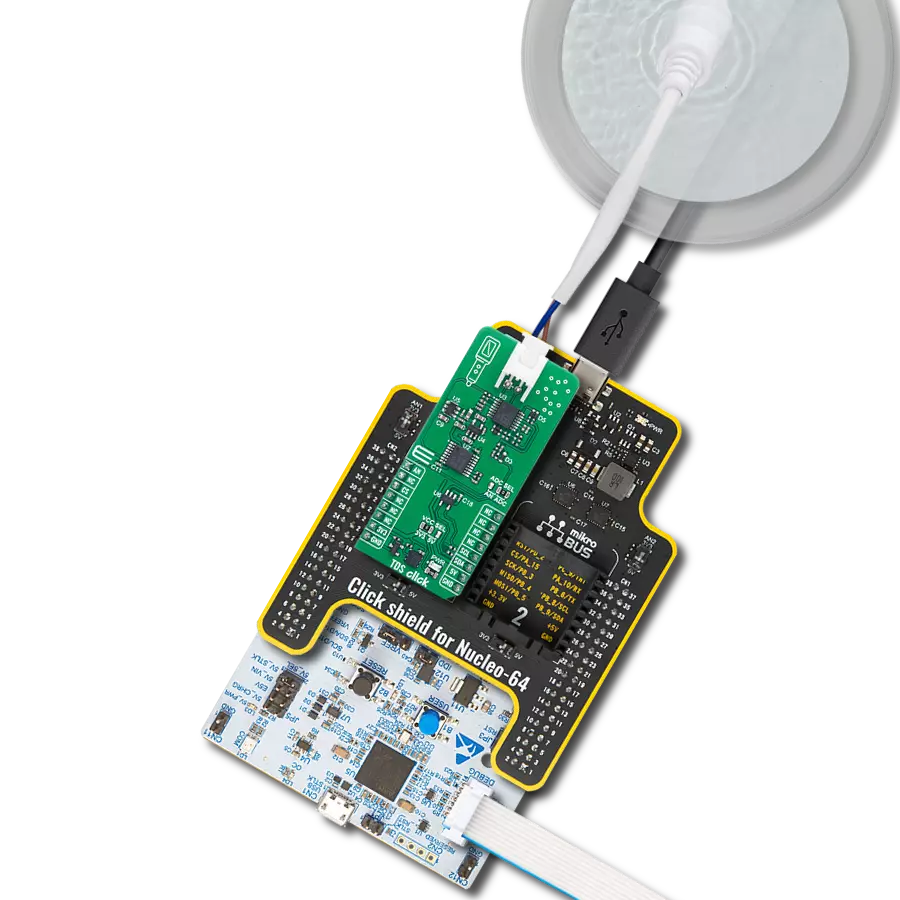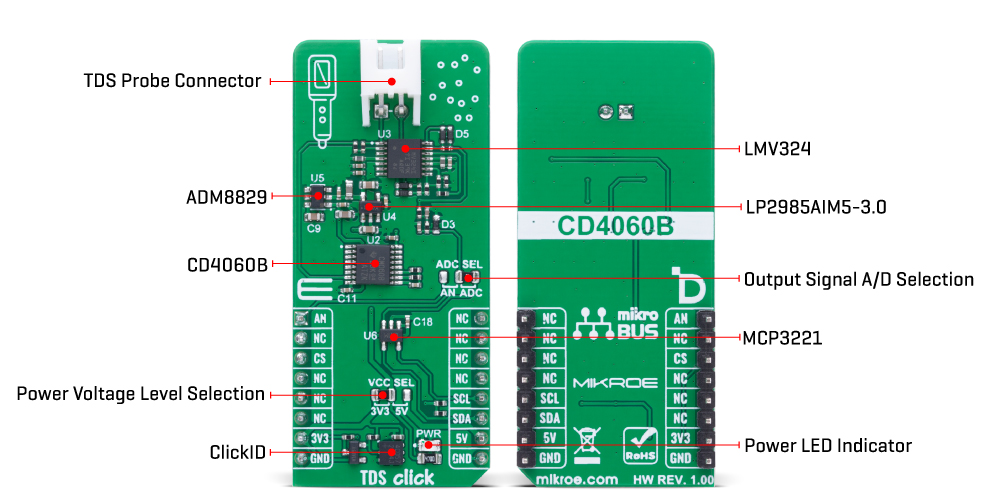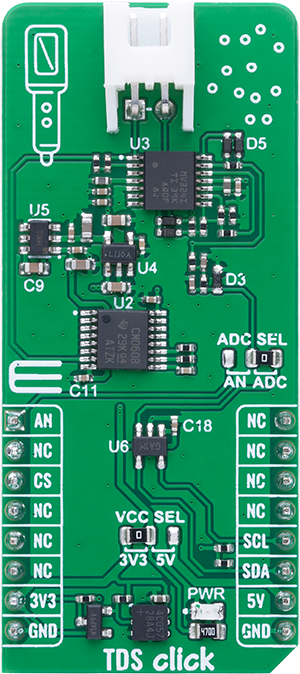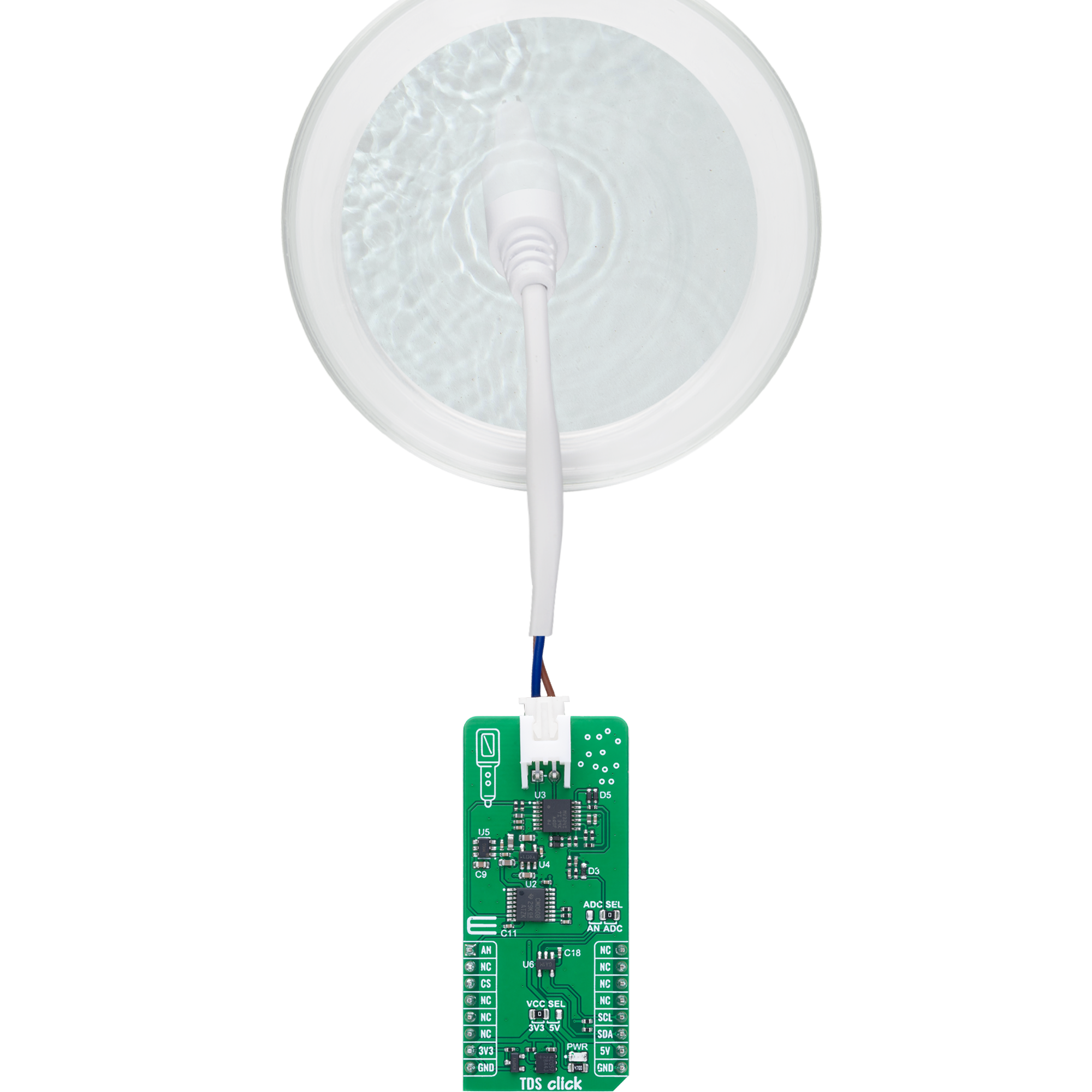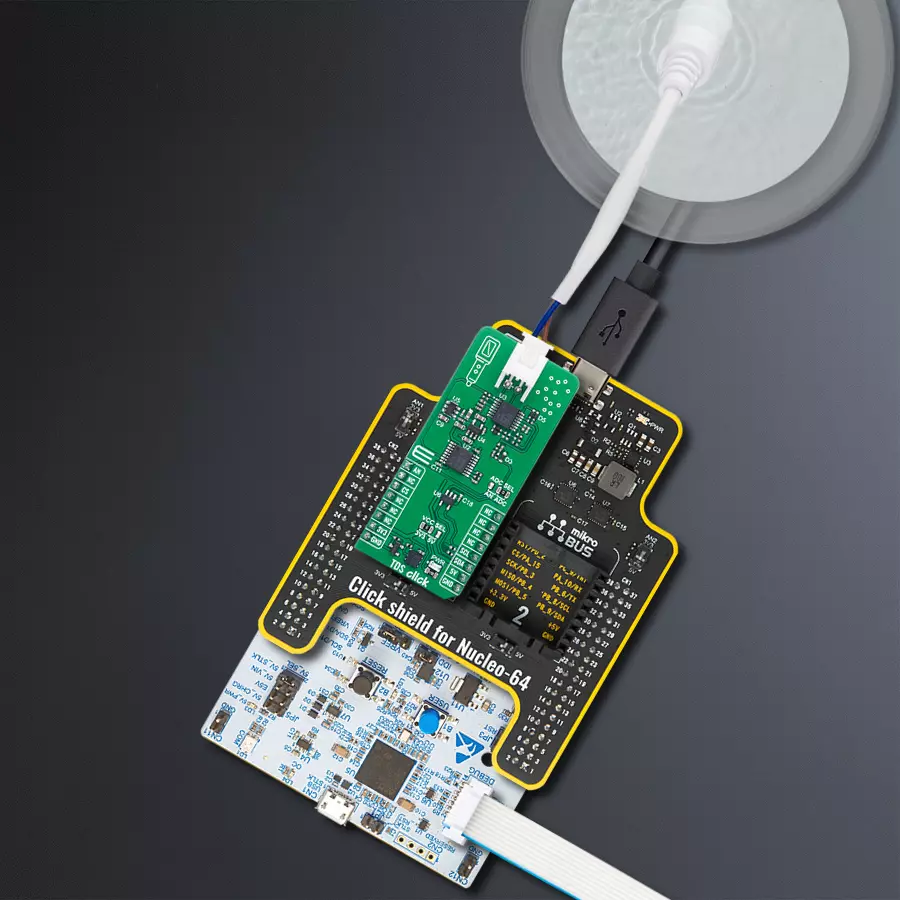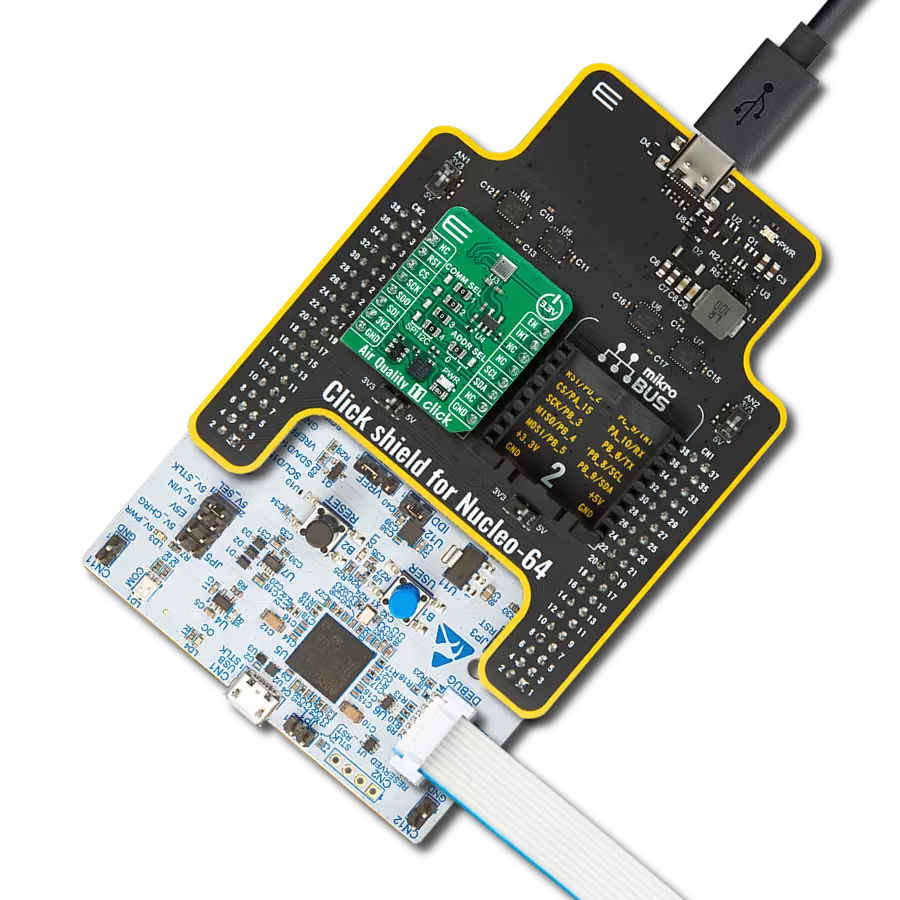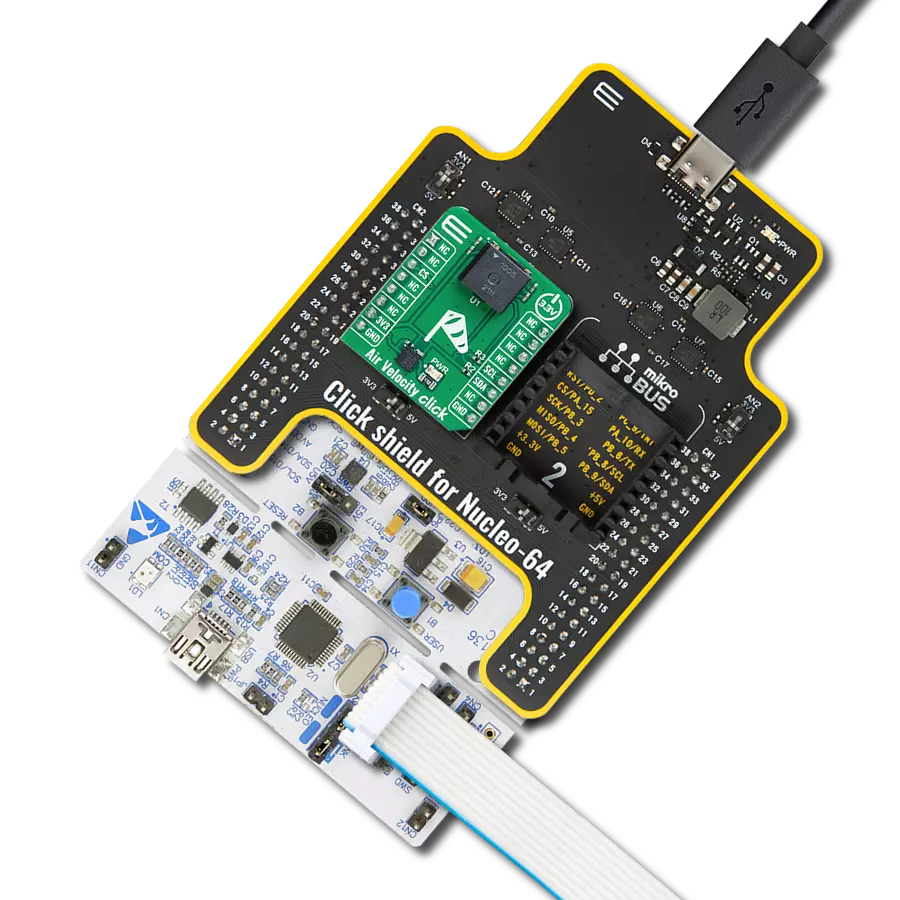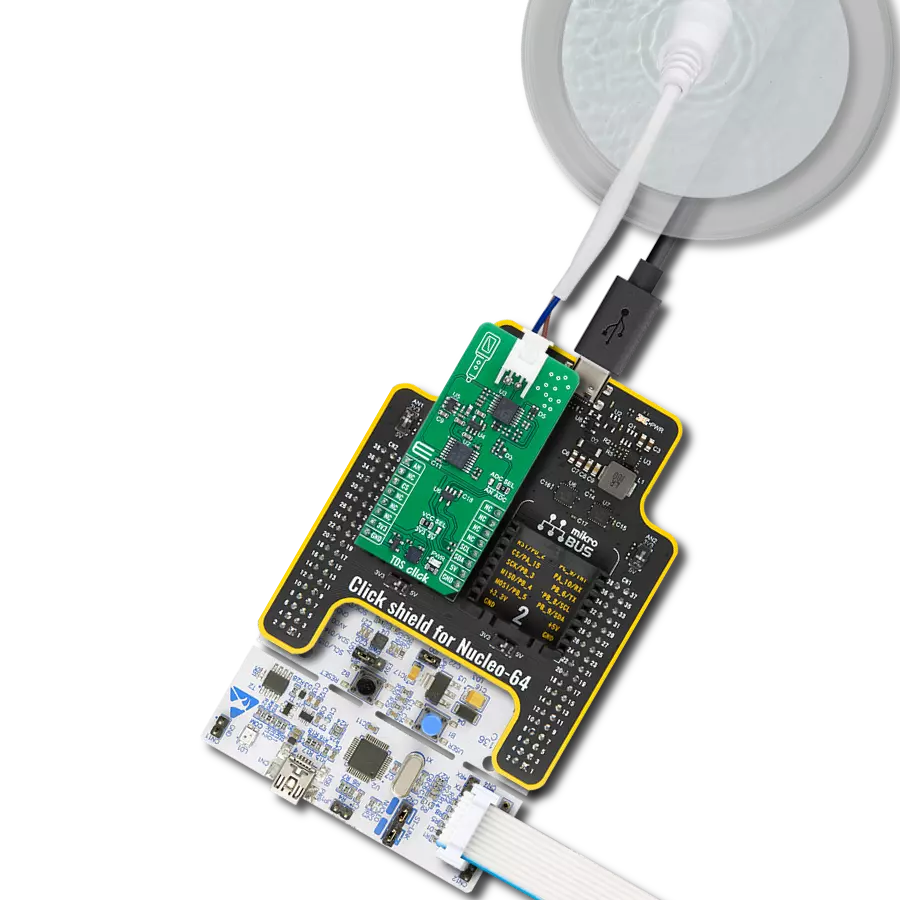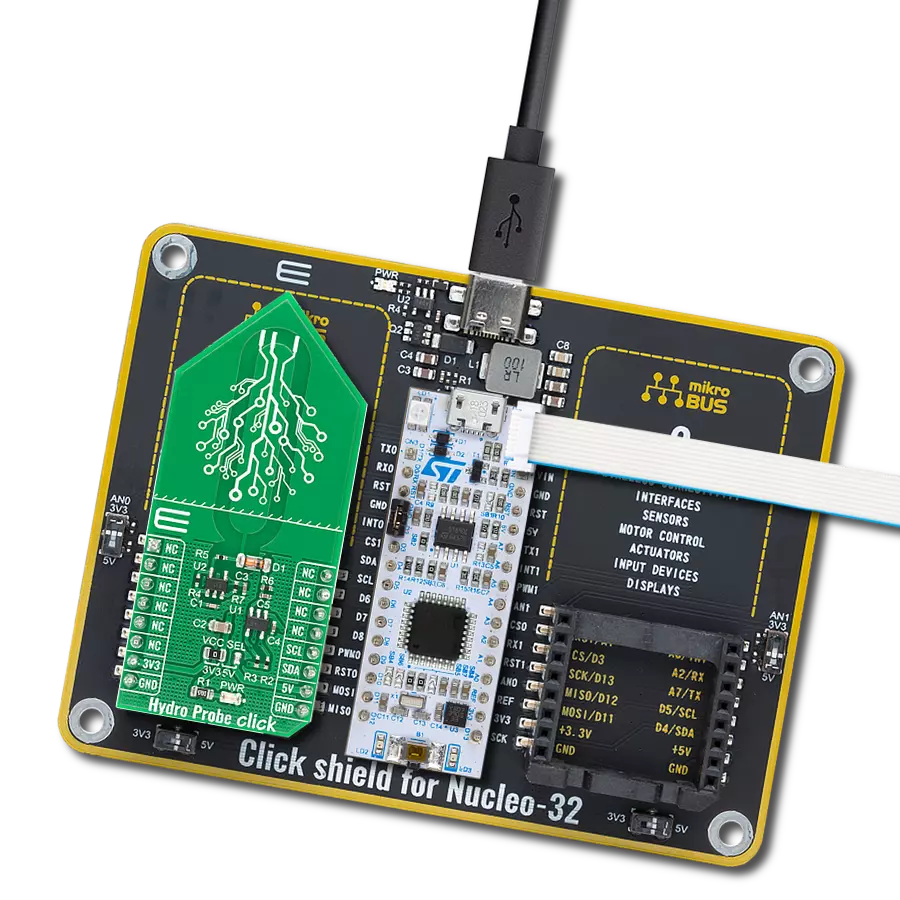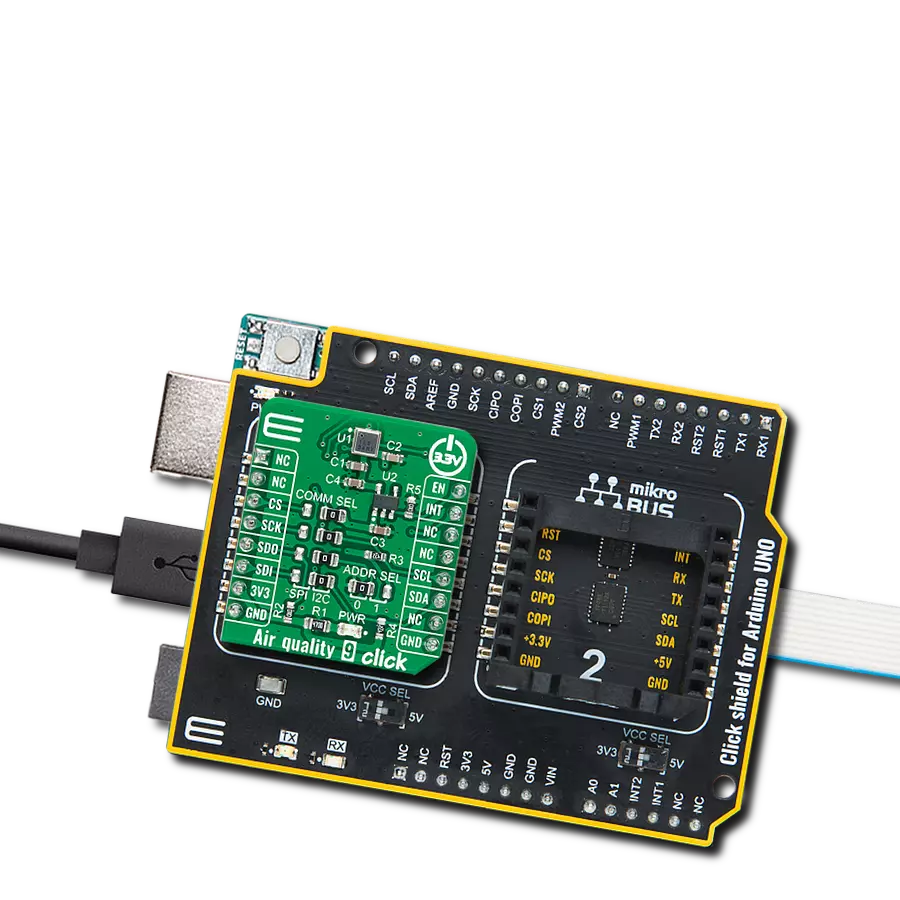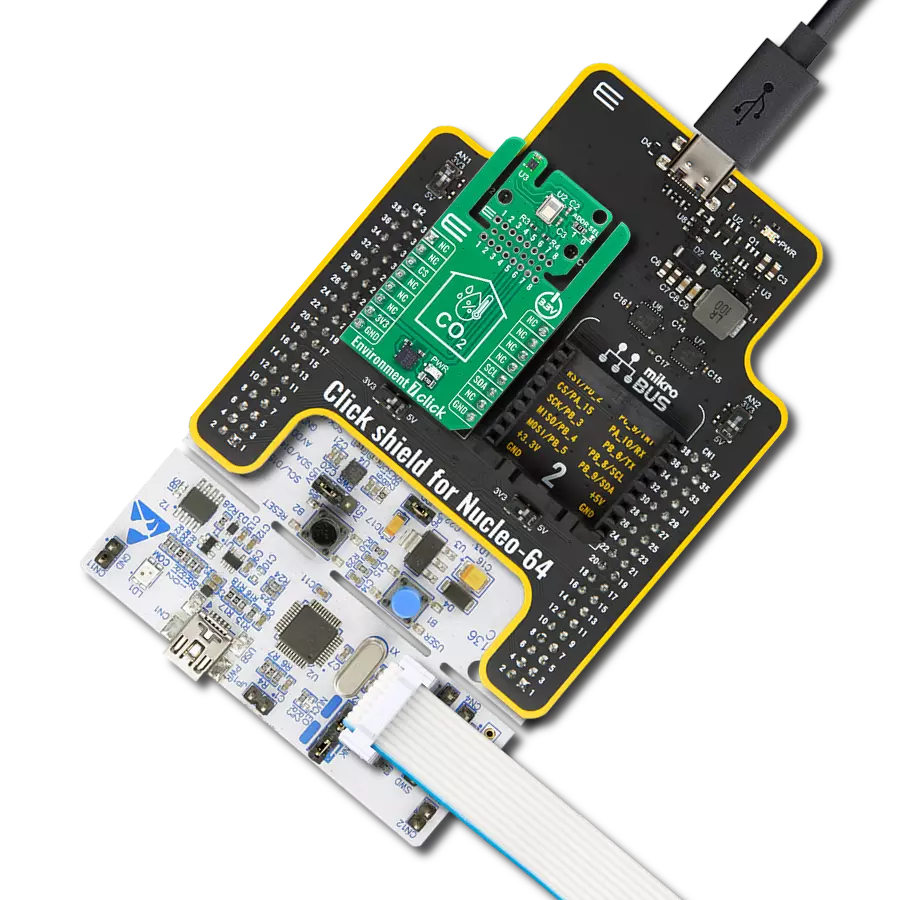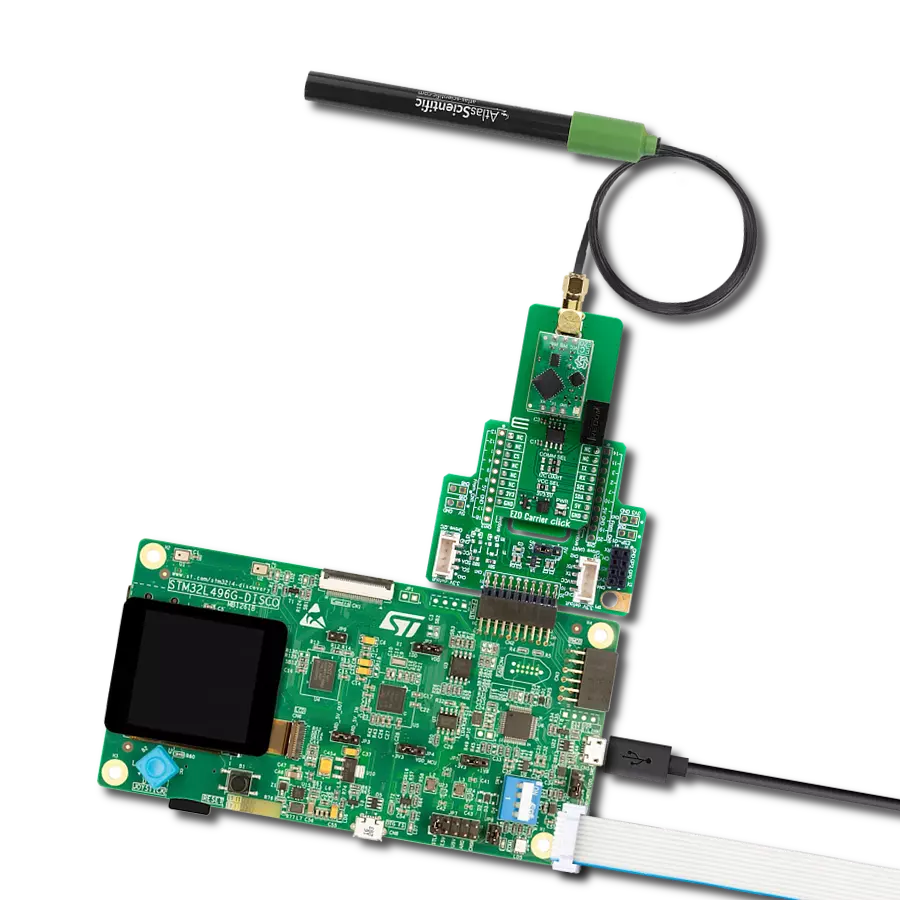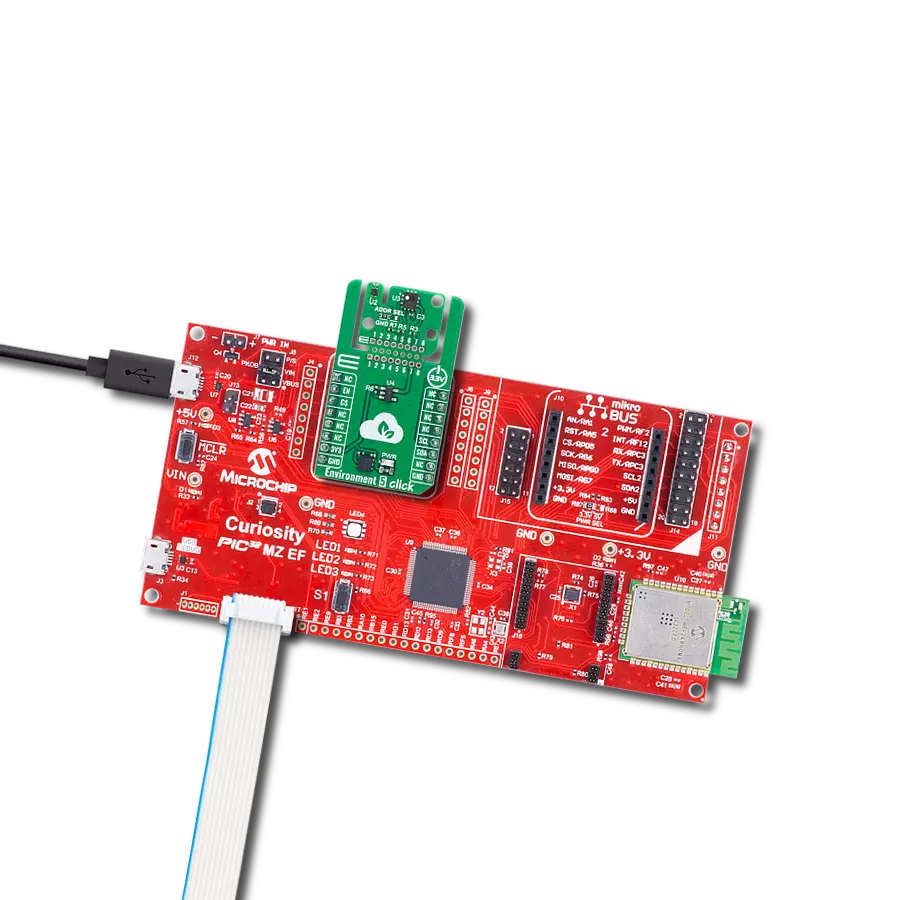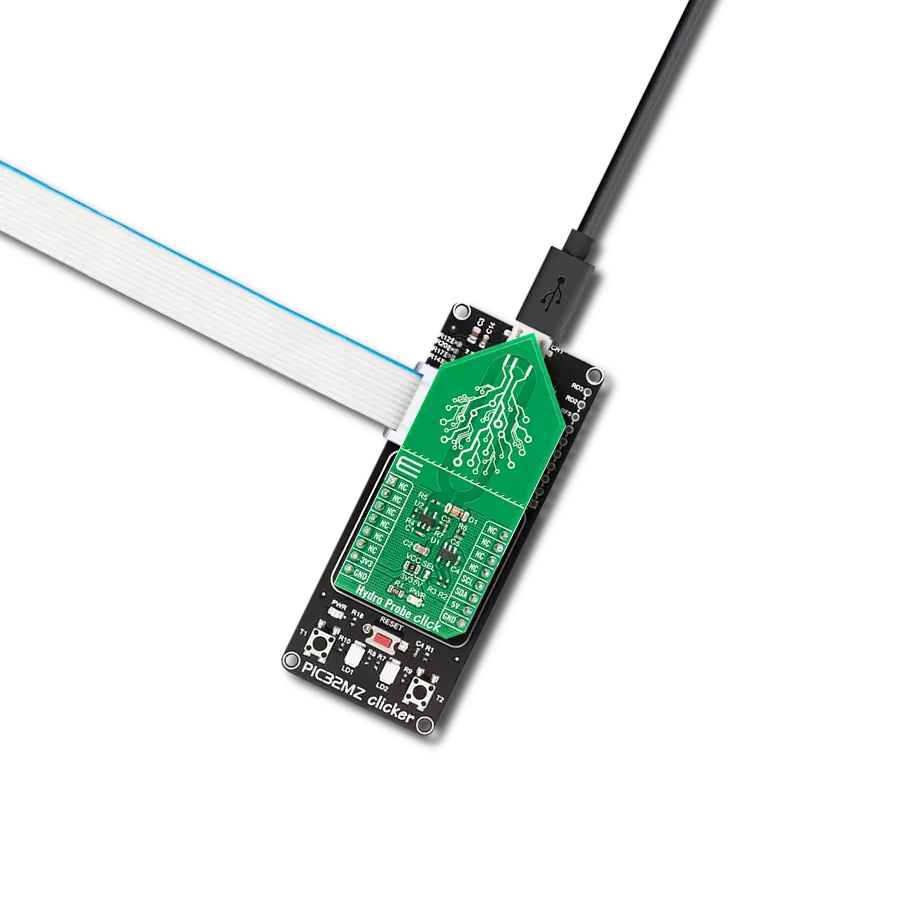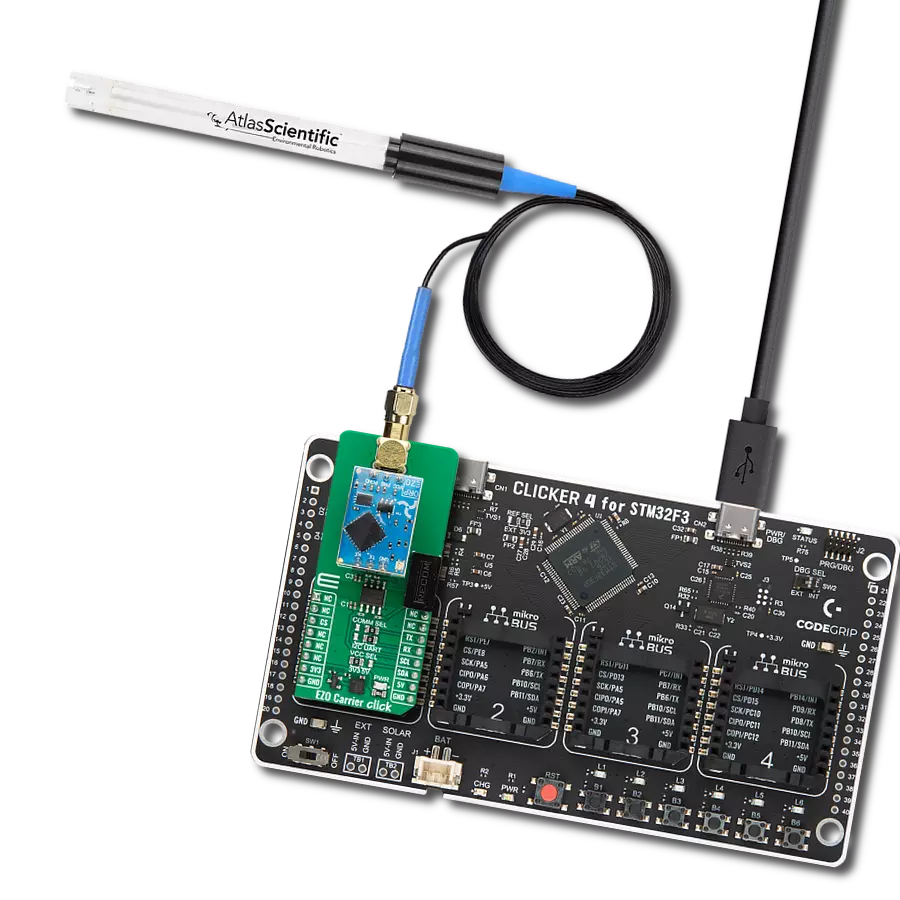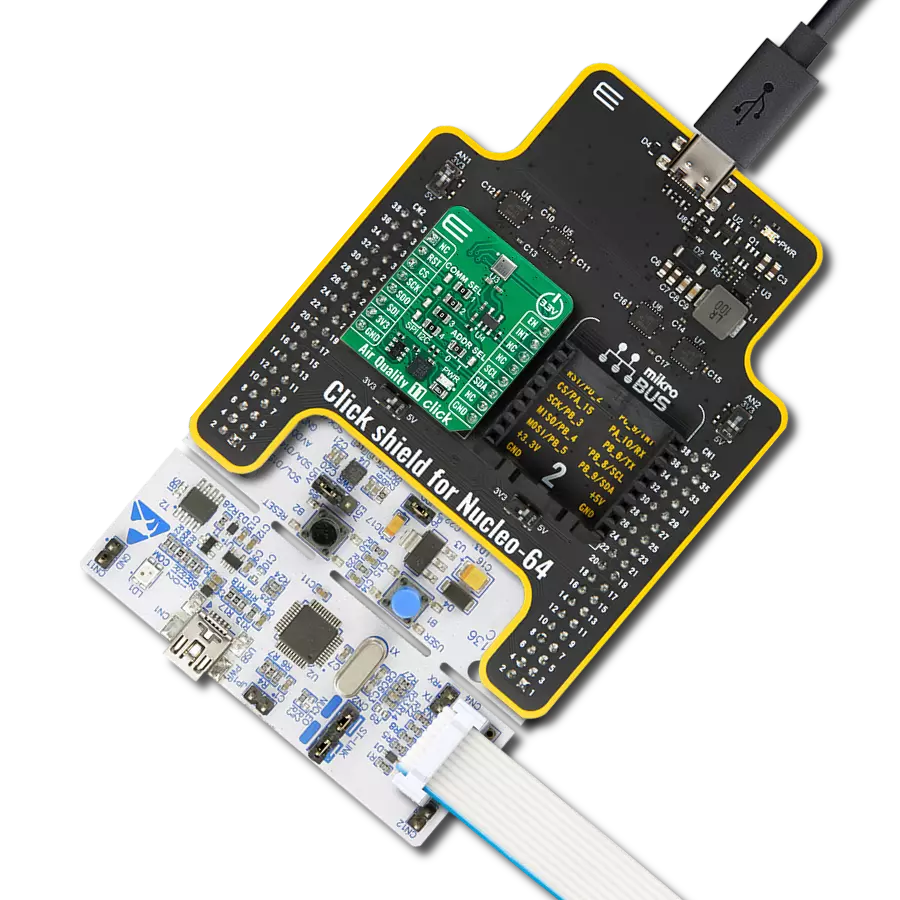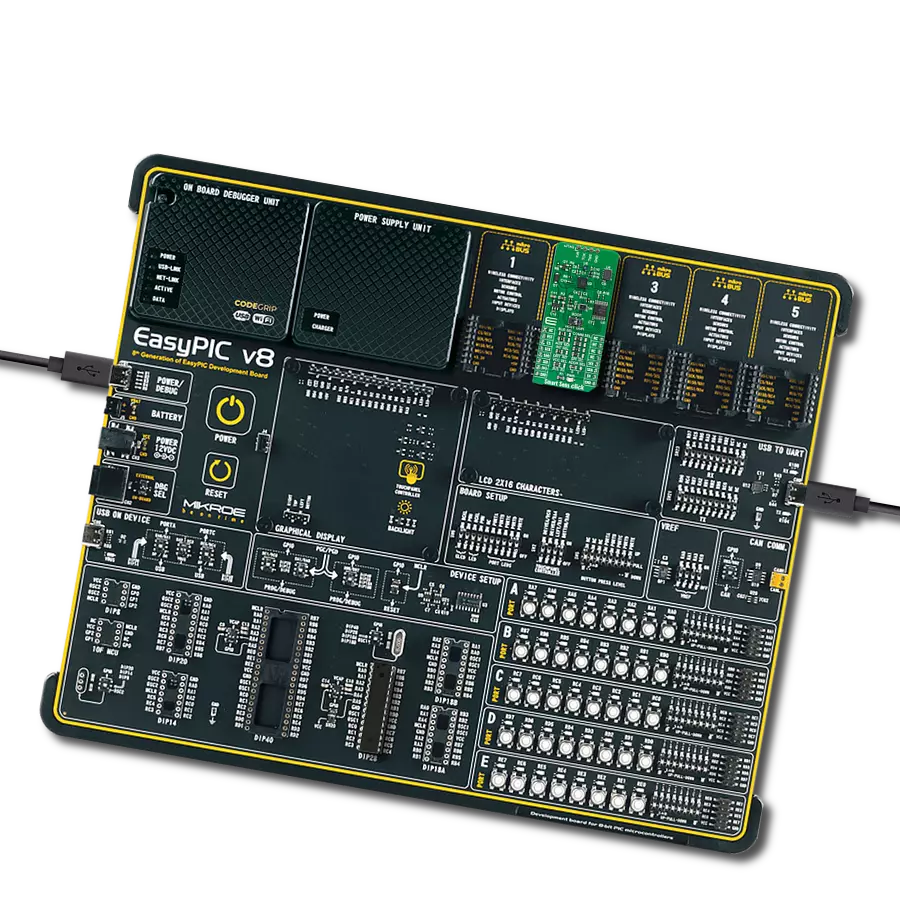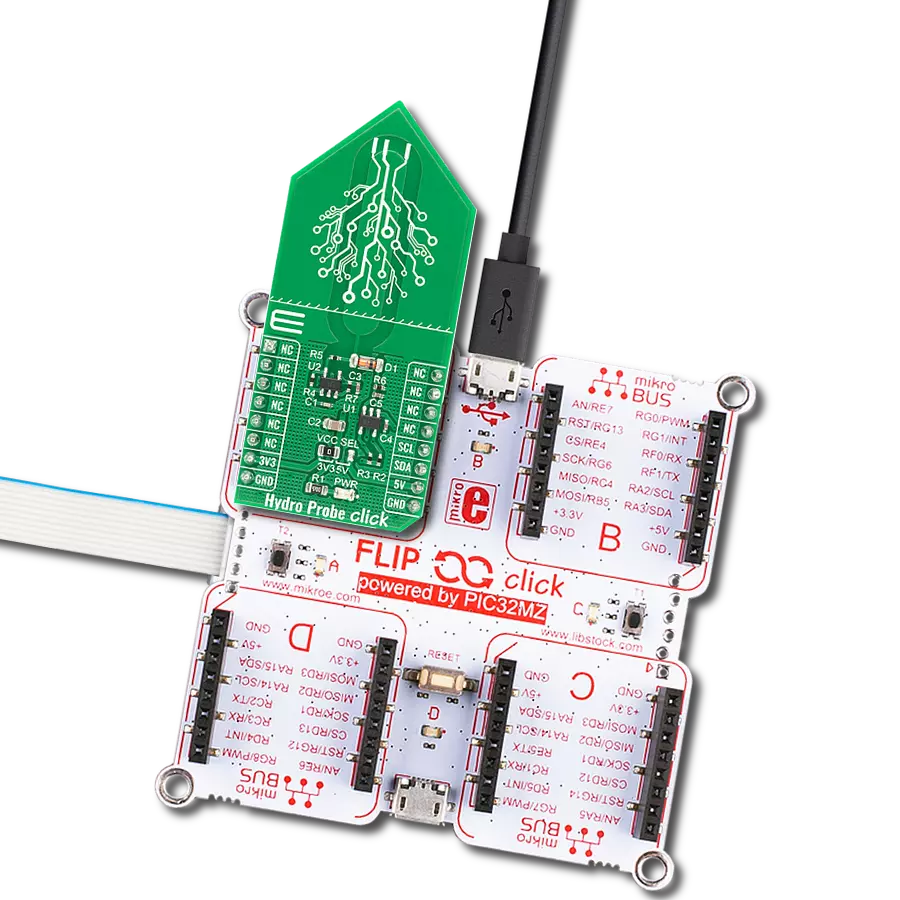Provide water quality data perfect for hydroponics and filtration systems
A
A
Hardware Overview
How does it work?
TDS Click is designed to measure the Total Dissolved Solids (TDS) levels in water, providing a reliable indication of water quality. The measurement process begins with the connection of an external TDS Water Quality Testing Probe via the onboard connector positioned at the top of the board. This probe detects the amount of dissolved solids in water, a crucial parameter for assessing overall water purity. At the heart of the circuit is the CD4060B from Texas Instruments, a key component responsible for generating the clock signal required to drive the TDS probe. This oscillator circuit operates on a dual supply voltage of +3.0V and -3.0V, which is essential for the subsequent signal processing stages. The voltage regulation is handled by two additional components: U4 (LP2985AIM5-3.0) delivers a stable +3.0V output from the selected mikroBUS™ power rail (VCC SEL), while U5 (ADM8829) performs voltage inversion, generating -3.0V from
the generated 3.0V source. These voltages are necessary to power the operational amplifiers used in the signal conditioning chain. The core signal conditioning and amplification tasks are performed by the LMV324, a rail-to-rail operational amplifier also from Texas Instruments. Initially, one stage of the op-amp is used to amplify the oscillator signal, providing enough drive for the connected TDS probe. The signal from the probe then passes through multiple additional stages of the LMV324, each serving a specific function in preparing the signal for final measurement. These stages buffer or further amplify the weak input from the probe, then rectify it to convert the AC signal into a positive DC waveform. This waveform is then filtered, resulting in a clean DC voltage that accurately represents the TDS concentration in the tested water. This final processed signal is routed to the ADC SEL jumper, which gives the user flexibility to select between analog and digital
output modes. If the analog output is preferred, the signal can be accessed directly through the AN pin of the mikroBUS™ socket. For digital conversion, the board integrates the MCP3221 from Microchip, a 12-bit resolution analog-to-digital converter that communicates over a standard 2-wire I2C interface. The mode selection is easily configured via the onboard SMD jumper labeled ADC SEL, allowing users to switch between the analog (AN) and digital (ADC) output positions according to their application needs. This Click board™ can operate with either 3.3V or 5V logic voltage levels selected via the VCC SEL jumper. This way, both 3.3V and 5V capable MCUs can use the communication lines properly. Also, this Click board™ comes equipped with a library containing easy-to-use functions and an example code that can be used as a reference for further development.
Features overview
Development board
Nucleo-64 with STM32G474R MCU offers a cost-effective and adaptable platform for developers to explore new ideas and prototype their designs. This board harnesses the versatility of the STM32 microcontroller, enabling users to select the optimal balance of performance and power consumption for their projects. It accommodates the STM32 microcontroller in the LQFP64 package and includes essential components such as a user LED, which doubles as an ARDUINO® signal, alongside user and reset push-buttons, and a 32.768kHz crystal oscillator for precise timing operations. Designed with expansion and flexibility in mind, the Nucleo-64 board features an ARDUINO® Uno V3 expansion connector and ST morpho extension pin
headers, granting complete access to the STM32's I/Os for comprehensive project integration. Power supply options are adaptable, supporting ST-LINK USB VBUS or external power sources, ensuring adaptability in various development environments. The board also has an on-board ST-LINK debugger/programmer with USB re-enumeration capability, simplifying the programming and debugging process. Moreover, the board is designed to simplify advanced development with its external SMPS for efficient Vcore logic supply, support for USB Device full speed or USB SNK/UFP full speed, and built-in cryptographic features, enhancing both the power efficiency and security of projects. Additional connectivity is
provided through dedicated connectors for external SMPS experimentation, a USB connector for the ST-LINK, and a MIPI® debug connector, expanding the possibilities for hardware interfacing and experimentation. Developers will find extensive support through comprehensive free software libraries and examples, courtesy of the STM32Cube MCU Package. This, combined with compatibility with a wide array of Integrated Development Environments (IDEs), including IAR Embedded Workbench®, MDK-ARM, and STM32CubeIDE, ensures a smooth and efficient development experience, allowing users to fully leverage the capabilities of the Nucleo-64 board in their projects.
Microcontroller Overview
MCU Card / MCU
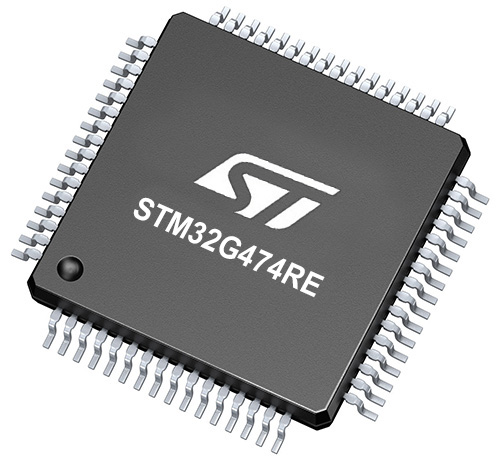
Architecture
ARM Cortex-M4
MCU Memory (KB)
512
Silicon Vendor
STMicroelectronics
Pin count
64
RAM (Bytes)
128k
You complete me!
Accessories
Click Shield for Nucleo-64 comes equipped with two proprietary mikroBUS™ sockets, allowing all the Click board™ devices to be interfaced with the STM32 Nucleo-64 board with no effort. This way, Mikroe allows its users to add any functionality from our ever-growing range of Click boards™, such as WiFi, GSM, GPS, Bluetooth, ZigBee, environmental sensors, LEDs, speech recognition, motor control, movement sensors, and many more. More than 1537 Click boards™, which can be stacked and integrated, are at your disposal. The STM32 Nucleo-64 boards are based on the microcontrollers in 64-pin packages, a 32-bit MCU with an ARM Cortex M4 processor operating at 84MHz, 512Kb Flash, and 96KB SRAM, divided into two regions where the top section represents the ST-Link/V2 debugger and programmer while the bottom section of the board is an actual development board. These boards are controlled and powered conveniently through a USB connection to program and efficiently debug the Nucleo-64 board out of the box, with an additional USB cable connected to the USB mini port on the board. Most of the STM32 microcontroller pins are brought to the IO pins on the left and right edge of the board, which are then connected to two existing mikroBUS™ sockets. This Click Shield also has several switches that perform functions such as selecting the logic levels of analog signals on mikroBUS™ sockets and selecting logic voltage levels of the mikroBUS™ sockets themselves. Besides, the user is offered the possibility of using any Click board™ with the help of existing bidirectional level-shifting voltage translators, regardless of whether the Click board™ operates at a 3.3V or 5V logic voltage level. Once you connect the STM32 Nucleo-64 board with our Click Shield for Nucleo-64, you can access hundreds of Click boards™, working with 3.3V or 5V logic voltage levels.
The Water Quality Sensor – TDS Water Quality Testing Probe is designed to measure the Total Dissolved Solids (TDS) level in water, providing a reliable indication of water purity. Suitable for use with TDS measurement circuits, this probe detects changes in electrical conductivity, which correlate with the concentration of dissolved substances in the water. It operates with a wide input voltage range of 3.3V to 5V and delivers an analog output voltage from 0V to 2.3V, making it compatible with most microcontroller platforms. The sensor is optimized for applications such as monitoring the quality of purified water, filtration system diagnostics, and hydroponic solutions. Featuring quick and secure installation, a sealed design to prevent leakage, and a long operational lifespan, this probe offers a practical solution for real-time water quality monitoring.
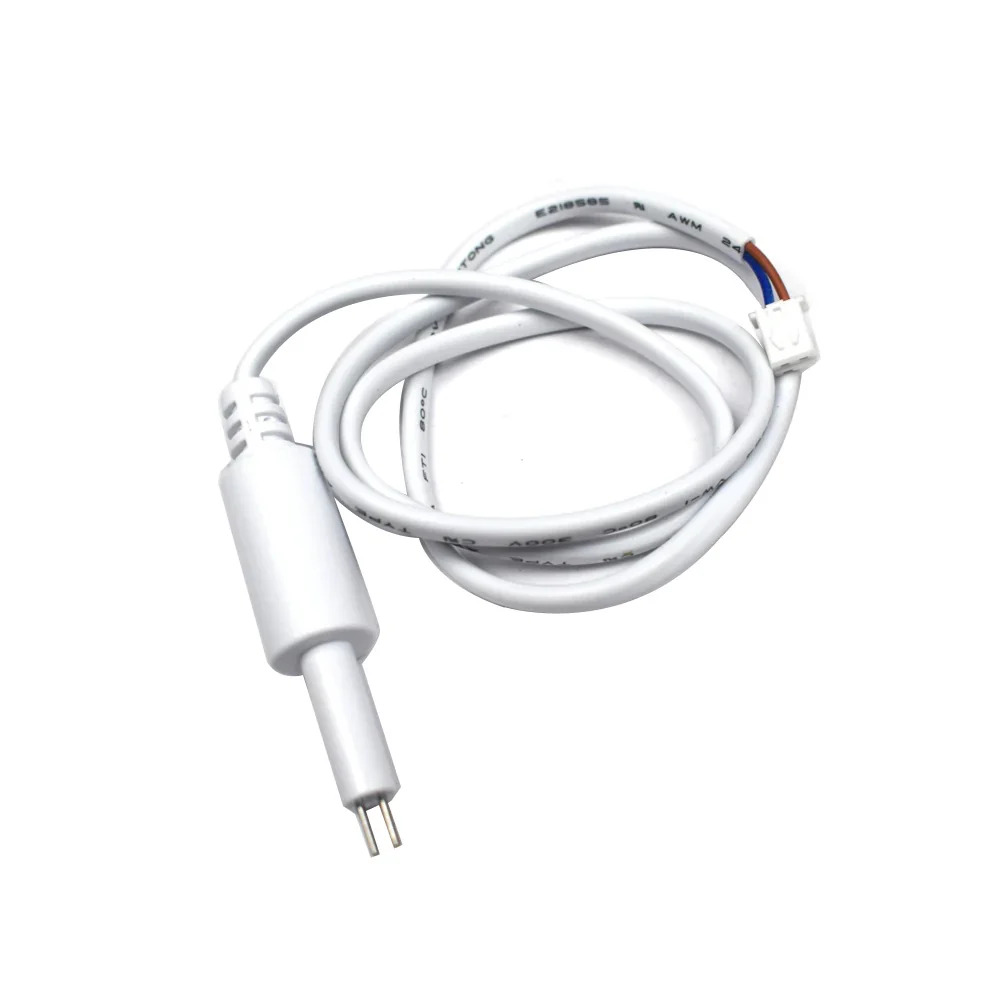
Used MCU Pins
mikroBUS™ mapper
Take a closer look
Click board™ Schematic
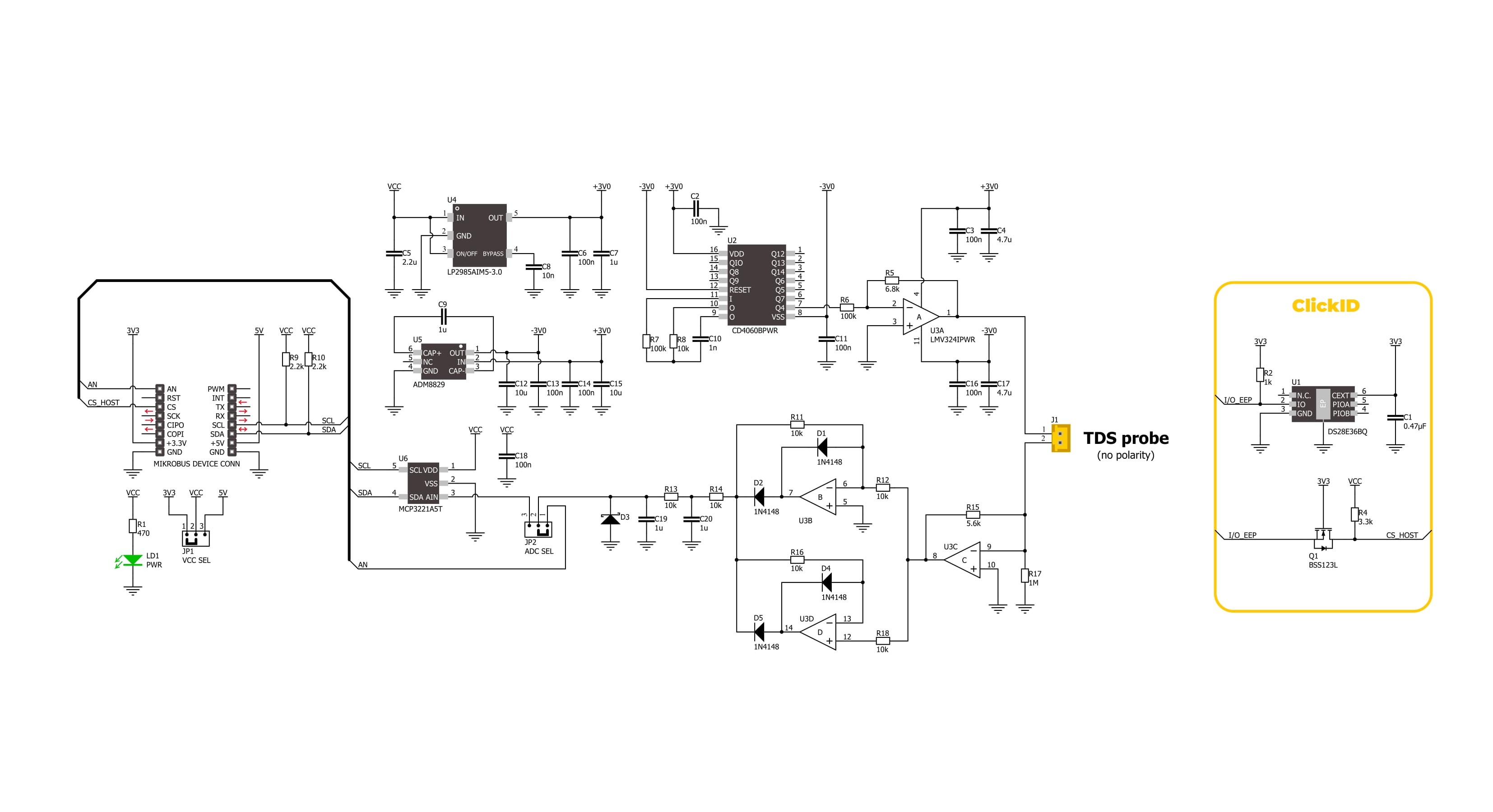
Step by step
Project assembly
Software Support
Library Description
TDS Click demo application is developed using the NECTO Studio, ensuring compatibility with mikroSDK's open-source libraries and tools. Designed for plug-and-play implementation and testing, the demo is fully compatible with all development, starter, and mikromedia boards featuring a mikroBUS™ socket.
Example Description
This example demonstrates the usage of the TDS Click board, which measures the Total Dissolved Solids (TDS) in water. The application initializes the TDS Click board, establishes communication, and continuously reads the TDS value in parts per million (ppm).
Key functions:
tds_cfg_setup- This function initializes Click configuration structure to initial values.tds_init- This function initializes all necessary pins and peripherals used for this Click board.tds_set_vref- This function sets the voltage reference for TDS Click driver.tds_read_voltage_avg- This function reads a desired number of ADC samples and calculates the average voltage level.tds_read_ppm- This function reads the TDS measurement value in ppm.
Application Init
Initializes the logger and configures the TDS Click board. It sets up communication using either ADC or I2C, verifies proper initialization, and prepares the device for measurement.
Application Task
Continuously reads the TDS value from the sensor and logs it in ppm (parts per million).
Open Source
Code example
The complete application code and a ready-to-use project are available through the NECTO Studio Package Manager for direct installation in the NECTO Studio. The application code can also be found on the MIKROE GitHub account.
/*!
* @file main.c
* @brief TDS Click Example.
*
* # Description
* This example demonstrates the usage of the TDS Click board, which measures the Total
* Dissolved Solids (TDS) in water. The application initializes the TDS Click board,
* establishes communication, and continuously reads the TDS value in parts per million (ppm).
*
* The demo application is composed of two sections:
*
* ## Application Init
* Initializes the logger and configures the TDS Click board. It sets up communication
* using either ADC or I2C, verifies proper initialization, and prepares the device
* for measurement.
*
* ## Application Task
* Continuously reads the TDS value from the sensor and logs it in ppm (parts per million).
*
* @note
* Ensure a proper TDS probe is attached to the Click board for accurate measurements.
*
* @author Stefan Filipovic
*
*/
#include "board.h"
#include "log.h"
#include "tds.h"
static tds_t tds; /**< TDS Click driver object. */
static log_t logger; /**< Logger object. */
void application_init ( void )
{
log_cfg_t log_cfg; /**< Logger config object. */
tds_cfg_t tds_cfg; /**< Click config object. */
/**
* Logger initialization.
* Default baud rate: 115200
* Default log level: LOG_LEVEL_DEBUG
* @note If USB_UART_RX and USB_UART_TX
* are defined as HAL_PIN_NC, you will
* need to define them manually for log to work.
* See @b LOG_MAP_USB_UART macro definition for detailed explanation.
*/
LOG_MAP_USB_UART( log_cfg );
log_init( &logger, &log_cfg );
log_info( &logger, " Application Init " );
// Click initialization.
tds_cfg_setup( &tds_cfg );
TDS_MAP_MIKROBUS( tds_cfg, MIKROBUS_1 );
err_t init_flag = tds_init( &tds, &tds_cfg );
if ( ( ADC_ERROR == init_flag ) || ( I2C_MASTER_ERROR == init_flag ) )
{
log_error( &logger, " Communication init." );
for ( ; ; );
}
log_info( &logger, " Application Task " );
}
void application_task ( void )
{
float tds_ppm = 0;
if ( TDS_OK == tds_read_ppm ( &tds, &tds_ppm ) )
{
log_printf( &logger, " TDS Value : %.1f ppm\r\n\n", tds_ppm );
Delay_ms ( 1000 );
}
}
int main ( void )
{
/* Do not remove this line or clock might not be set correctly. */
#ifdef PREINIT_SUPPORTED
preinit();
#endif
application_init( );
for ( ; ; )
{
application_task( );
}
return 0;
}
// ------------------------------------------------------------------------ END
Additional Support
Resources
Category:Environmental
